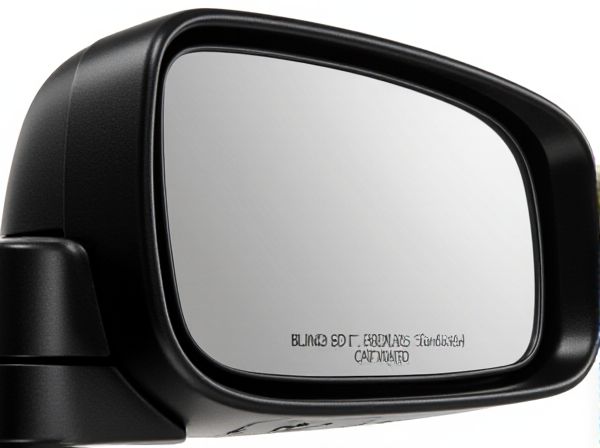
Photo illustration: Blind Spot Mirror vs Standard Mirror
Blind spot mirrors provide an expanded field of view, allowing you to see areas that standard mirrors often miss, which enhances driving safety. These small, convex mirrors attach to your vehicle's side mirrors, reducing blind spots and minimizing the risk of accidents during lane changes. Investing in blind spot mirrors can significantly improve your awareness and confidence on the road.
Table of Comparison
| Feature | Blind Spot Mirror | Standard Mirror |
|---|---|---|
| Purpose | Enhances visibility in blind spots | Provides general rearview visibility |
| Design | Small, convex, attachable mirror | Flat or slightly curved mirror integrated into car |
| Field of View | Wide-angle view covering blind spots | Standard rear and side view |
| Safety Benefit | Reduces accidents from unseen vehicles | Basic situational awareness |
| Installation | Easy, adhesive or clip-on | Factory installed |
| Cost | Low to moderate | Included with vehicle |
| Ideal For | Drivers focusing on blind spot safety | General driving and rear visibility |
Introduction to Blind Spot Mirrors and Standard Mirrors
Blind spot mirrors are small, convex mirrors attached to the corner of standard side mirrors, designed to expand the field of view and minimize blind spots that standard mirrors often miss. Standard mirrors, typically flat or slightly curved, provide a direct line of sight to adjacent lanes but have limited coverage around the vehicle's rear and sides. Incorporating blind spot mirrors enhances safety by reducing the risk of collisions during lane changes and merges.
How Standard Mirrors Work
Standard mirrors function by reflecting light directly from objects within their field of view, offering a straightforward image with limited peripheral visibility. These mirrors typically have a flat surface that provides a true-to-scale reflection but fail to capture areas outside the immediate line of sight, known as blind spots. This limitation necessitates careful head movement or the use of supplementary devices like blind spot mirrors to enhance overall situational awareness while driving.
Understanding Blind Spot Mirrors
Blind spot mirrors are small convex mirrors attached to the side mirrors, designed to expand the driver's field of vision by capturing areas not visible in standard mirrors. Unlike standard mirrors, which provide a flat reflection of the rearview, blind spot mirrors minimize blind spots, enhancing safety by revealing vehicles or obstacles in adjacent lanes. Proper placement and adjustment of blind spot mirrors are essential for maximizing visibility and reducing collision risks during lane changes.
Key Differences Between Blind Spot and Standard Mirrors
Blind spot mirrors are designed with a convex shape to provide a wider field of view, significantly reducing the driver's blind spots compared to standard flat mirrors. Standard mirrors offer a more natural, undistorted reflection but have limited visibility areas, which often miss vehicles in adjacent lanes. Blind spot mirrors enhance safety by improving lateral vision and helping drivers detect nearby obstacles or vehicles that standard mirrors typically fail to capture.
Safety Benefits of Blind Spot Mirrors
Blind spot mirrors significantly enhance driver safety by expanding the field of view beyond what standard mirrors offer, reducing the risk of collisions during lane changes or merges. These auxiliary mirrors eliminate hidden areas where other vehicles often go unnoticed, providing critical situational awareness especially on highways. Installing blind spot mirrors can decrease accidents caused by blind spots by up to 20%, proving essential for safer driving practices.
Limitations of Standard Mirrors
Standard mirrors often have narrow fields of view that create blind spots, increasing the risk of accidents during lane changes or merges. Their flat surface fails to provide adequate peripheral visibility, limiting drivers' ability to detect vehicles in adjacent lanes. Blind spot mirrors enhance situational awareness by expanding the visual range, compensating for these inherent limitations of standard mirrors.
Installation and Compatibility
Blind spot mirrors offer easy installation with adhesive backing that attaches directly to existing side mirrors, ensuring compatibility with most vehicle makes and models without requiring professional tools or modifications. Standard mirrors, typically factory-installed or replacement parts, often require precise alignment and may need specific mounts or hardware compatible with the vehicle's design. Choosing a blind spot mirror enhances compatibility by providing a simple, universal upgrade that complements standard mirrors without altering the car's original setup.
Cost Comparison: Blind Spot vs Standard Mirrors
Blind spot mirrors typically cost between $10 and $30 per pair, while standard side mirrors range from $50 to $200 depending on the vehicle make and model. Installation expenses for blind spot mirrors are minimal, often involving simple adhesive attachment, whereas standard mirrors may require professional replacement costing $100 to $400 including parts and labor. Choosing blind spot mirrors offers a budget-friendly solution to enhance visibility without the higher investment associated with standard mirror replacements.
User Experience and Real-World Performance
Blind spot mirrors significantly enhance user experience by expanding the field of vision beyond what standard mirrors offer, reducing the risk of accidents during lane changes. In real-world performance, blind spot mirrors provide immediate visual feedback on vehicles in adjacent lanes, minimizing blind zones and improving reaction time. Standard mirrors often require frequent head-turning, whereas blind spot mirrors integrate seamlessly to improve safety without compromising comfort.
Which Mirror is Best for Your Vehicle?
Blind spot mirrors offer enhanced visibility by providing a wider field of view, reducing the risk of accidents caused by hidden vehicles in adjacent lanes. Standard mirrors, while essential for general rearview purposes, often lack the ability to eliminate blind spots effectively. Choosing the best mirror depends on your driving needs, with blind spot mirrors being ideal for increased safety during lane changes and standard mirrors suitable for everyday rear visibility.
 caratoz.com
caratoz.com